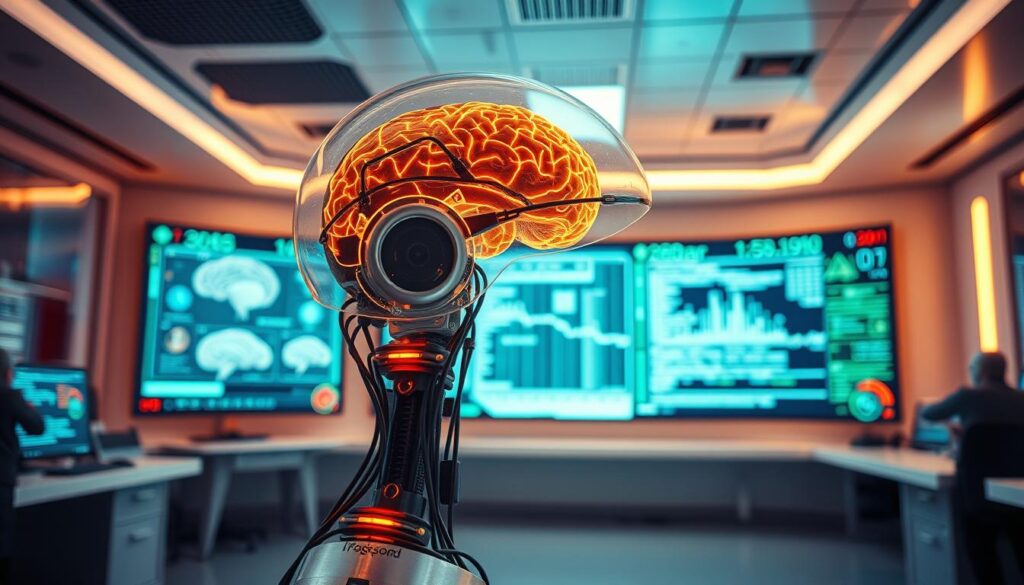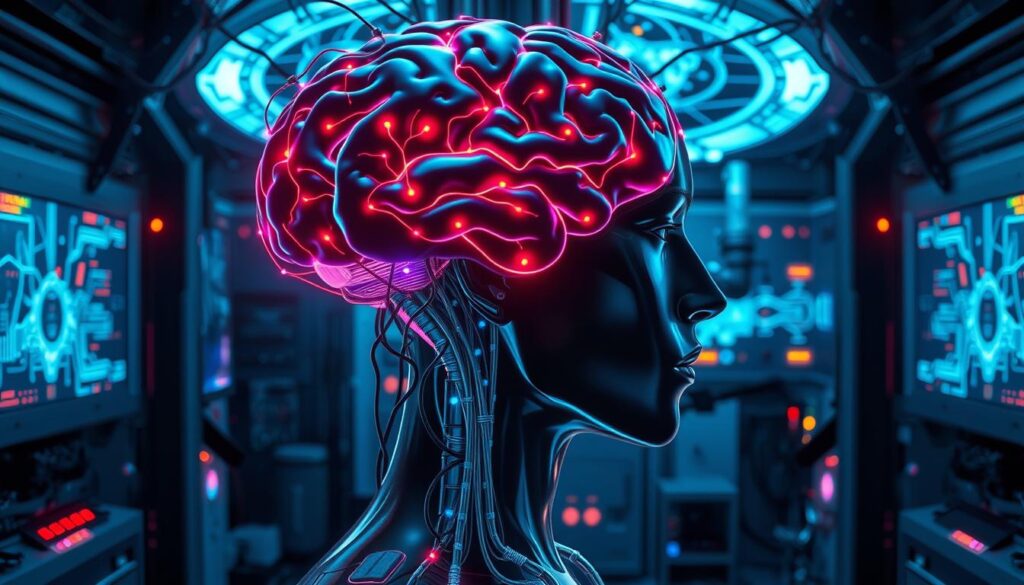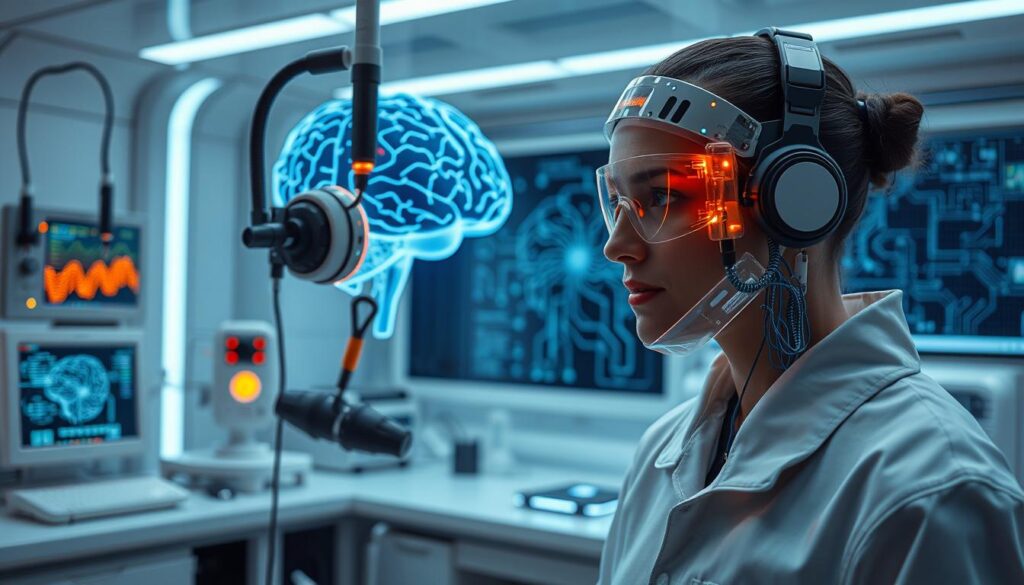Elon Musk’s Neuralink is leading a new wave in brain-computer interfaces. It combines human neurobiology with cutting-edge tech. This move could greatly advance neurotechnology.
Looking into Neuralink news, we see it’s more than just tech. It’s about making a real difference in people’s lives, mainly for those with neurological issues. So far, three people have gotten Neuralink implants, showing early success.
Neuralink wants to make these implants even better. They aim to change how we use technology and improve life for those with disabilities.

Key Takeaways
- Neuralink has reported three successful human implantations of their brain-computer interface.
- Aiming to expand trials, Neuralink plans to involve 20 to 30 additional individuals this year.
- The technology allows users to engage in activities like playing video games, showing impressive functionality.
- Neuralink’s devices aim to bridge gaps in human capability, specially for those with paralysis or spinal cord injuries.
- With more than 45 ongoing trials in BCIs across various companies, the landscape of neurotechnology is actively evolving.
Introduction to Neuralink
Neuralink is a major leap in brain-computer interfaces (BCIs). It was started in 2016 by Elon Musk. The goal is to make it easy for people to talk to devices with their minds.
It’s important to know about BCIs to understand Neuralink’s goals. This knowledge helps us see its possible uses.
Overview of Brain-Computer Interfaces
Brain-computer interfaces connect our brains to digital devices. They turn our brain signals into actions. This lets people control things with just their thoughts.
BCIs are getting more attention because of their many uses. They could help people with paralysis talk again.
The Vision Behind Neuralink
Elon Musk wants Neuralink to do more than just advance tech. He dreams of helping people with severe disabilities. He wants them to be able to live freely again.
Neuralink aims to make devices that fit into our lives smoothly. It’s all about making things easier and safer. Musk hopes it will lead to better teamwork between humans and machines.
Recent Developments in Elon Musk Neuralink
Early 2024 has seen big steps forward in brain-computer interface tech. Elon Musk has said three people now have his brain implants. These implants let users control digital stuff with their thoughts, showing great promise for the future.
Three Humans with Neuralink Implants
The first person got an implant in January 2024. They could control a computer mouse with their mind. This shows how powerful Musk’s brain implants can be.
A second person, with a spinal cord injury, is next. They’ve already started playing video games and using 3D software. This is a big step for those with paralysis.
Improvements in Technology
Neuralink tech has gotten a lot better. The latest device has 1,024 electrodes. Future versions will have even more, making it even better.
Neuralink plans to test more people in 2024. Musk hopes to test thousands soon. This tech could really help those with severe motor problems.

Neuralink Technology and Trials
Neuralink is leading in neurotechnology, with big steps in its clinical trials. These trials check if its brain-computer interfaces (BCIs) are safe and work well. The latest neuralink trial updates show how much progress has been made after getting FDA approval in May 2023.
Details of the Clinical Trials
Recent trials involve a device called “the Link.” It has 1,024 electrodes to catch neuron activity. This small chip connects to a special piece that handles brain signals.
The surgical robots used make the implantation precise and quick. This helps a lot with neuralink safety. The trials aim to last five years. They want to help people with severe paralysis control their limbs or prosthetics.
Safety and Functionality Focus
Safety is key in these trials. The government watches closely to make sure patients are safe. An institutional review board checks on patient care and device performance.
Engineers keep working on the tech, thinking about its ethics. Neurotechnology elon musk aims to improve human abilities with BCIs. They focus on safe innovation.
Comparison with Other Companies
Neuralink is not alone in BCI technology. Synchron and Blackrock Neurotech also work on this. They offer different solutions, showing different levels of invasiveness and design.
Neuralink’s advanced robotic surgery is unique. But, neuralink competitors are catching up fast. They all aim to make good brain-machine interfaces available.

Impact on Users and Future Prospects
The advancements in elon musk neuralink technology are set to change lives. They will help those with severe physical disabilities. Users can control devices with their thoughts, improving daily life.
This means they can use computers or control robotic limbs. It makes communication and interaction easier.
Benefits for Individuals with Paralysis
For those with paralysis, neuralink offers hope. Devices like the N1 chip use over 1,000 flexible threads. They allow users to communicate or control their bodies with their thoughts.
Early trials show great results. They highlight the immediate benefits and life-changing impact. These innovations make technology easier to use and empower people to join society more fully.
Potential Future Applications
The future of neuralink goes beyond helping those with physical limitations. It could improve memory recall and help with neurological disorders. Neuralink might even allow memory uploads to artificial intelligence.
This could change how we think and remember. Integrating BCIs with advanced systems, like Tesla’s Optimus robot, shows a future where humans and machines interact smoothly.
Challenges and Controversies Facing Neuralink
Neuralink’s progress has sparked big talks about ethics. The company’s animal testing has raised big worries about animal welfare. Over 1,500 animals have died in Neuralink’s research, sparking concerns about ethics.
Animal Testing and Ethical Considerations
Animal testing in neuralink is under a lot of scrutiny. There’s a big debate between pushing technology forward and keeping ethics in check. The high death rate among animals has raised questions about the rush in research.
Also, the strict rules for who can join the research raise ethical questions. People with quadriplegia or ALS are chosen, but there’s doubt about their full understanding of the risks. The hype around new tech can cloud the truth about its real benefits and dangers.
Public Perception and Regulatory Scrutiny
Elon Musk’s involvement in neuralink has split opinions. Some see it as groundbreaking, while others question its ethics and the risks. This split makes it hard to gauge public opinion as regulatory challenges grow.
Regulators like the U.S. Department of Agriculture are now looking into Neuralink. They’re checking if the company followed animal welfare laws. Past issues with brain-computer interface firms have also raised doubts about Neuralink’s future.
Conclusion
Neuralink is stepping into the world of neurotechnology, aiming to change how we interact with our brains. The latest human trials show great progress, with three people successfully getting implants. This is a big step forward for Neuralink.
These advancements could help people with disabilities use technology better. It could also give them more freedom and independence.
But, there are also big challenges ahead. Safety, ethics, and rules are key concerns for Neuralink. It’s important to move forward responsibly in this new field.
Neuralink wants to do more than just invent new tech. It aims to help people and make technology a part of our minds. As things change, we need to keep looking at the good and bad sides of Neuralink’s work.
FAQ
What is Neuralink and what technology does it use?
Neuralink is a company founded by Elon Musk. It works on brain-computer interfaces (BCIs). These interfaces let people control devices with their minds.
They use special electrodes and algorithms to turn brain signals into commands.
How does Neuralink’s technology benefit individuals with disabilities?
Neuralink’s tech could greatly improve life for people with disabilities. It could let paralyzed individuals control computers and robots with their thoughts.
This would give them more independence and control over their world.
What recent advancements have been made with Neuralink’s brain implants?
By 2023, Neuralink had tested its implants on three people. The second person could play video games and use 3D modeling software.
These early results show promise. The technology is getting better with more electrodes and longer battery life.
What are the current stages of Neuralink’s clinical trials?
Neuralink is testing its implants in humans. They got approval from the FDA and Health Canada.
The trials are checking if the implants are safe and work well. They’re also watching how the implants interact with the brain.
What ethical concerns surround Neuralink’s animal testing practices?
Neuralink’s animal testing has raised ethical questions. About 1,500 animals died during studies.
There’s a big debate about how to balance technology progress with animal welfare.
How does Neuralink compare with other companies in the neurotechnology field?
Neuralink is part of a competitive field. Companies like Synchron and Blackrock Neurotech are also working on BCIs.
While Neuralink uses robots, others might offer better options. It depends on what you need.
What are the future applications of Neuralink technology?
Neuralink’s tech could be used in many ways. It might help control advanced robots, like Tesla’s Optimus.
This could change how we interact with machines. It could even connect our brains directly to machines.